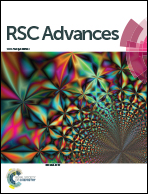Large scale combustion synthesis of glass-γ-Fe2O3 double shell composite hollow microspheres with tunable magnetic property†
Abstract
Glass-γ-Fe2O3 double shell composite hollow microspheres (DSCHMs) with low density and tunable magnetic properties were fabricated through a novel fast dehydration–combustion route. Micron-sized single shell hollow microspheres (SSHMs) with a uniform silicate glass shell were formed firstly by spray drying pelleting and subsequent high temperature melting in flame. Then γ-Fe2O3 shells were assembled on the preformed SSHMs by a fast sol combustion route. By properly tuning the process conditions and the component of the reactant, a series of composites (DSCHMs) with gradients in thickness of the shell layer can be prepared. The magnetic properties of the DSCHMs were studied and the results demonstrate that they present ferrimagnetic properties related to the thickness of the maghemite shell. The maghemite shell can be thermally reduced to metallic iron by hydrogen to get glass–Fe composite DSCHMs with enhanced magnetic properties. This work provides a new strategy to fabricate shelled hollow microspheres with tailored shell thickness through controlled assembly of metal oxide shells, which can be expected to be extended to the controlled assembly of other oxides or compounds onto different cores.


 Please wait while we load your content...
Please wait while we load your content...